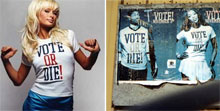
New York
Daily NewsMonday, November 20th, 2006
There's a quiet revolution going on in music, made all more surprising since it's coming from the normally noisy world of rock.
While the media were snoozing, a rash of low-key guitar-based bands have wormed their way up the charts, to the point where such groups now dominate the nation's download portals, leaving most hip-hop acts, and even many pop ones, in their sales wake.
Most music fans couldn't pick the members of bands like Hinder and the Fray out of a lineup. But each boasts an album that just sailed past the million mark, with the momentum to move far more.
These Midwest-based-bands have also recently landed the two most downloaded songs in the country: Hinder with "Lips of an Angel" and the Fray with "How to Save a Life."
At the same time, the faceless Kansas band Blue October has stealthily moved more than 600,000 copies of its latest CD, "Foiled." And the critically abhorred act Nickelback continues to post spectacular figures for its "All the Right Reasons" CD, all without a peep from the press.
After 58 weeks, Nickelback's disk remains in the top 20 of Billboard's album chart, with sales closing in on 4 million. That's the highest figure for any album on the Top 200 now. It's also some 2.5 million more CDs than have been moved by the best-selling rap act this year (T.I.).
Rock albums have also been lingering on the charts longer of late than those of any other genre. A full 30% of the disks currently logging more than 25 weeks on Billboard's Top 200 list belong to guitar-based bands. So far, Hinder's CD, "Extreme Behavior," has held on the list for 40 weeks and, if anything, is only picking up sales speed. Same with the Fray, which after 44 weeks is moving more units per week of "How to Save a Life" than it did six months ago.
So, why hasn't the press paid ample heed to these cornfed bands?
To Joe Levy, executive editor of Rolling Stone, it's partially a regional issue. "The rock press is, for the most part, based in New York, and the music business is mainly in L.A.," he explains. "It's been true for decades that bands which do better in the Midwest, like these, don't get as much attention. That's held true whether you're talking about REO Speedwagon in the '70s, Journey in the '80s or Hinder now."
According to radio analyst Sean Ross, acts like the Fray and Nickelback also get far less airtime in places like New York than in the middle of the country. To boot, Ross thinks the essential blandness of these bands lowers their media profile. "They're not extreme enough for the hard-rock people and not hip enough for the underground people," he says.
Doug Brod, editor of Spin, feels the problem has to do with these bands' lack of originality. "They sound like a lot of other bands out there," he says. "Hinder and Nickelback are like third-generation grunge bands. It's a fake Candlebox, who were fake Pearl Jam. The Fray sounds like Coldplay, a far superior band with better songs and a better sound."
Then there's the hipness problem to consider. None of these groups came from any underground scene. They have no edge to their sound, or their personalities, so a hip magazine like Spin has no use for them. Rolling Stone has finally done a major Hinder feature, but only after the album entered the top 10.
If these groups don't have press credibility behind them they still get plenty of TV exposure. All have appeared on the late-night talk shows. The Fray's song "How to Save a Life" sold in key part through its prominent usage on "Grey's Anatomy."
Then again, having your song used mainly as background music only highlights the ironic anonymity of bands this huge. Brod thinks the groups shouldn't mind their low profile. "If I were in a band that succeeded without the help of the national press, I would be stoked," he says. "It's more of an accomplishment."
Levy agrees, at least in part. "If you can put 10 million dollars in the bank and can play to 17,000 adoring fans in an arena, what does it matter that 100 guys in glasses don't really like your work?" he asks. "And, yet, it does matter. Performers are driven by the need for validation. They always want more."











